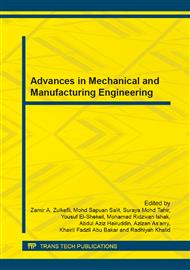[1]
UNCTAD, Information onhttp: /unctad. org/en/Docs/rmt2011_en. pdf.
Google Scholar
[2]
W.C. Ng, European Journal of Operational Research, Vol. 164, (1) (2005), pp.64-78.
Google Scholar
[3]
S.K. Das and A. Spasovic, Production Planning & Control, Vol. 14, (7) (2003), pp.623-633.
Google Scholar
[4]
K.H. Kim and Y. -M. Park, European Journal of Operational Research, Vol. 156, (3) ( 2004), p.752–768.
Google Scholar
[5]
I.F.A. Vis, I. Harika, Spectrum, Vol. 26, (1) (2004), p.117–143.
Google Scholar
[6]
V.D. Nguyen, K.H. Kim, Comput. Ind. Eng., Vol. 56, (3) (2009), p.1002–1020.
Google Scholar
[7]
S.H.R. Sadeghian, M.K.A. Ariffin, S.H. Tang, N. Ismail, Advances in Intelligent Systems and Computing, in press.
Google Scholar
[8]
S.H.R. Sadeghian, M.K.A. Ariffin, S.H. Tang, N. Ismail, Advanced Materials Research, in press.
Google Scholar
[9]
W.C. Ng, European Journal of Operational Research, Vol. 164, (1) (2005), pp.64-78.
Google Scholar
[10]
S.K. Das and A. Spasovic, Production Planning & Control, Vol. 14, (7) (2003), pp.623-633.
Google Scholar
[11]
A. Imai, K. Sasaki, E. Nishimura and S. Papadimitriou, Er J Oper Res, Vol. 171, (2) (2006), p.373–389.
Google Scholar
[12]
D.H. Lee, J.X. Cao and Q.X. Shi, in the IEEE International Conference on Industrial Engineering and Engineering Management, IEEM 2008, Singapore (2008), pp.1219-1223.
Google Scholar
[13]
D.H. Lee, Z. Cao and Q. Meng, Int J Product Econom, Vol. 107, (1) (2007), p.115–124.
Google Scholar
[14]
Carlo, H. J., I. F. A. Vis, et al., Flexible Services and Manufacturing Journal (2013), pp.1-39.
Google Scholar
[15]
P. J. M. Meersmans and A. P. M. Wagelmans, Tech. Rep., Erasmus Research Institute of Management (ERIM), Erasmus University, Rotterdam, The Netherlands(2001).
Google Scholar
[16]
Lau, H. and Y. Zhao, Annals of Operations Research, Vol. 159(1) (2008), pp.373-394.
Google Scholar
[17]
S. M. Homayouni, S. H. Tang, N. Ismail, M. K. A. Ariffin, International Journal of Physical Sciences, Vol. 6 (27) (2011), pp.6286-6294.
Google Scholar


